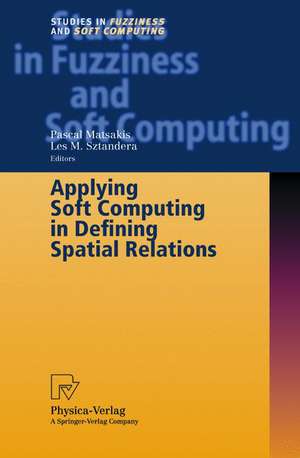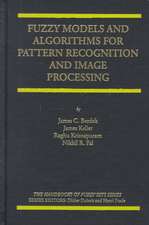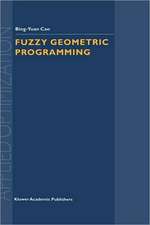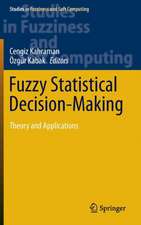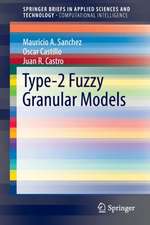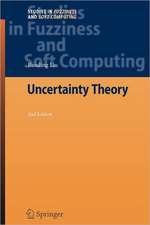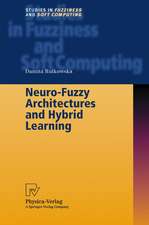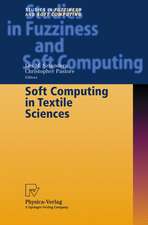Applying Soft Computing in Defining Spatial Relations: Studies in Fuzziness and Soft Computing, cartea 106
Editat de Pascal Matsakis, Les M. Sztanderaen Limba Engleză Hardback – 4 sep 2002
| Toate formatele și edițiile | Preț | Express |
|---|---|---|
| Paperback (1) | 383.71 lei 6-8 săpt. | |
| Physica-Verlag HD – 8 aug 2012 | 383.71 lei 6-8 săpt. | |
| Hardback (1) | 391.61 lei 6-8 săpt. | |
| Physica-Verlag HD – 4 sep 2002 | 391.61 lei 6-8 săpt. |
Din seria Studies in Fuzziness and Soft Computing
- 20%
 Preț: 999.85 lei
Preț: 999.85 lei - 20%
 Preț: 653.06 lei
Preț: 653.06 lei - 20%
 Preț: 872.96 lei
Preț: 872.96 lei - 20%
 Preț: 930.57 lei
Preț: 930.57 lei - 20%
 Preț: 1051.00 lei
Preț: 1051.00 lei - 20%
 Preț: 992.44 lei
Preț: 992.44 lei - 20%
 Preț: 655.85 lei
Preț: 655.85 lei - 20%
 Preț: 1001.86 lei
Preț: 1001.86 lei - 18%
 Preț: 954.14 lei
Preț: 954.14 lei - 20%
 Preț: 330.10 lei
Preț: 330.10 lei - 20%
 Preț: 333.04 lei
Preț: 333.04 lei - 20%
 Preț: 997.56 lei
Preț: 997.56 lei - 20%
 Preț: 647.79 lei
Preț: 647.79 lei - 20%
 Preț: 986.01 lei
Preț: 986.01 lei - 18%
 Preț: 958.56 lei
Preț: 958.56 lei - 20%
 Preț: 996.40 lei
Preț: 996.40 lei - 20%
 Preț: 999.35 lei
Preț: 999.35 lei - 15%
 Preț: 646.43 lei
Preț: 646.43 lei - 20%
 Preț: 651.57 lei
Preț: 651.57 lei - 20%
 Preț: 997.89 lei
Preț: 997.89 lei - 15%
 Preț: 641.03 lei
Preț: 641.03 lei - 20%
 Preț: 1009.74 lei
Preț: 1009.74 lei - 20%
 Preț: 992.62 lei
Preț: 992.62 lei -
 Preț: 388.72 lei
Preț: 388.72 lei - 18%
 Preț: 1223.43 lei
Preț: 1223.43 lei - 20%
 Preț: 651.42 lei
Preț: 651.42 lei - 18%
 Preț: 951.59 lei
Preț: 951.59 lei - 18%
 Preț: 948.61 lei
Preț: 948.61 lei
Preț: 391.61 lei
Nou
Puncte Express: 587
Preț estimativ în valută:
74.93€ • 78.24$ • 62.02£
74.93€ • 78.24$ • 62.02£
Carte tipărită la comandă
Livrare economică 04-18 aprilie
Preluare comenzi: 021 569.72.76
Specificații
ISBN-13: 9783790815047
ISBN-10: 3790815047
Pagini: 224
Ilustrații: XIII, 205 p.
Dimensiuni: 155 x 235 x 18 mm
Greutate: 0.5 kg
Ediția:2002
Editura: Physica-Verlag HD
Colecția Physica
Seria Studies in Fuzziness and Soft Computing
Locul publicării:Heidelberg, Germany
ISBN-10: 3790815047
Pagini: 224
Ilustrații: XIII, 205 p.
Dimensiuni: 155 x 235 x 18 mm
Greutate: 0.5 kg
Ediția:2002
Editura: Physica-Verlag HD
Colecția Physica
Seria Studies in Fuzziness and Soft Computing
Locul publicării:Heidelberg, Germany
Public țintă
ResearchCuprins
Fuzzifying Spatial Relations.- 1 Motivation.- 2 Imprecision in Spatial Relations.- 3 Applying Allen’s Algorithm to Fuzzy Relations.- 4 Other Fuzzy Relations.- 5 Fuzzy Constraint Satisfaction.- 6 Conclusion.- Acknowledgement.- References.- Path Composition of Positional Relations Integrating Qualitative and Fuzzy Knowledge.- 1 Introduction.- 2 Composition of Positional Relations.- 3 Path Composition.- 4 Integrating Qualitative and Fuzzy Knowledge.- 5 Fuzzy Knowledge Coming from Particular Distance Systems.- 6 Conclusions.- Acknowledgments.- References.- Spatial Relations Based on Dominance of Fuzzy Sets.- 1 Spatial Relations.- 2 Spatial Relations Among Fuzzy Subsets.- References.- Mathematical Morphology and Spatial Relationships: Quantitative, Semi-Quantitative and Symbolic Settings.- 1 Introduction.- 2 Basic Morphological Operations, Fuzzy and Logical Extensions.- 3 Computing Spatial Relationships from Mathematical Morphology: Quantitative and Semi-Quantitative Setting.- 4 Spatial Representations of Spatial Relationships.- 5 Symbolic Representations of Spatial Relationships.- 6 Conclusion.- References.- Understanding the Spatial Organization of Image Regions by Means of Force Histograms: A Guided Tour.- 1 Introduction.- 2 The Notion of the Histogram of Forces.- 3 Comparing Force Histograms.- 4 Defining Fuzzy Spatial Relations.- 5 Generating Linguistic Spatial Descriptions.- 6 Conclusion.- Acknowledgments.- References.- Fuzzy Spatial Relationships and Mobile Agent Technology in Geospatial Information Systems.- 1 Introduction.- 2 Background.- 3 Fuzzy Directional Relationships and Querying.- 4 Extensions to the Model.- 5 Intelligent Agent Technology.- 6 Summary and Future Work.- Acknowledgments.- References.- Using Fuzzy Spatial Relations to Control Movement Behavior ofMobile Objects in Spatially Explicit Ecological Models.- 1 Introduction.- 2 Modeling Habitat Landscape.- 3 Fuzzy Control of Spatial Movement.- 4 Discussion.- References.- A Fuzzy Set Model of Approximate Linguistic Terms in Descriptions of Binary Topological Relations Between Simple Regions.- 1 Introduction.- 2 Related Literature.- 3 Fuzziness of Approximate Linguistic Terms — Preliminary Cognitive Evidences.- 4 A Fuzzy Set Model of Approximate Linguistic Terms.- 5 Discussion.- 6 Concluding Remarks.- Acknowledgements.- References.- About the Editors.
Caracteristici
Includes supplementary material: sn.pub/extras
